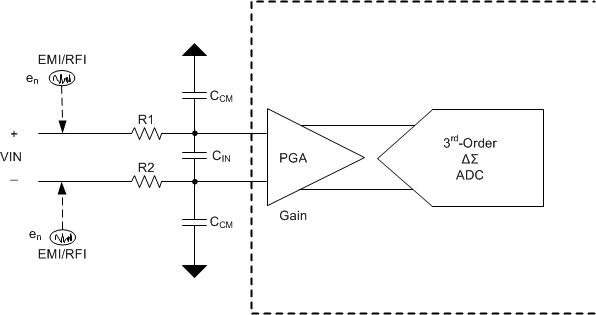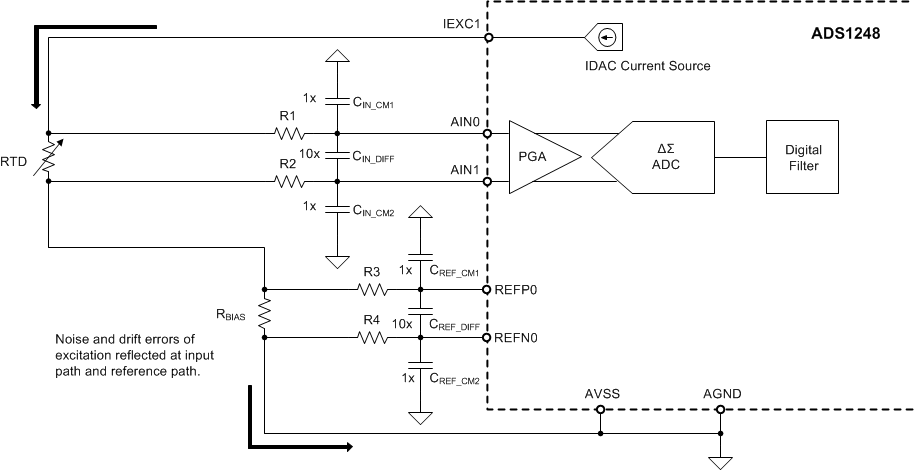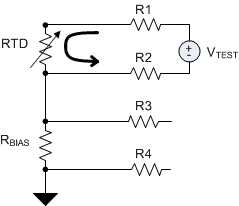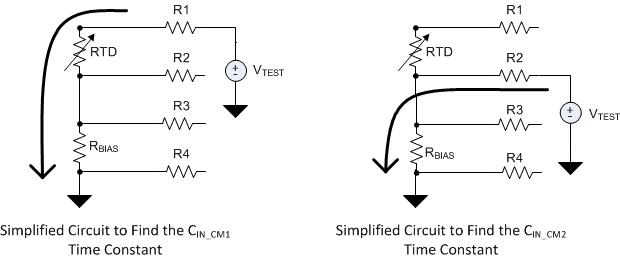SBAA201A March 2013 – March 2023 ADS1120 , ADS1120-Q1 , ADS1147 , ADS1148 , ADS114S06 , ADS114S06B , ADS114S08 , ADS114S08B , ADS1220 , ADS122C04 , ADS1247 , ADS1248 , ADS124S06 , ADS124S08
2 Low-Pass Filter Design Considerations in Ratiometric Measurements
In order for effective ratiometric cancellation to occur, the errors due to the excitation source drift and noise must be equally reflected at the inputs of the ADC, and at the reference inputs of the device. In this configuration, the excitation noise cancels, resulting in a stable, high-resolution measurement. In applications where external filters may be required to eliminate noise interference, make sure to balance the corner frequency of the reference low-pass filter to the corner frequency of the input low-pass filter.
 Figure 2-1 Typical Differential and
Common-Mode Filter
Figure 2-1 Typical Differential and
Common-Mode FilterThe circuit diagram of shows a generic circuit topology frequently used in front of differential amplifiers. The input path RC low-pass filter consists of two matched series resistors, one differential capacitor, and two common-mode capacitors. This passive filter provides a first-order 20-dB/decade roll-off characteristic.
This filter topology provides attenuation for both the differential and common-mode voltage signals. The differential capacitor value is typically chosen to be at least 10 times larger than the common-mode voltage capacitors. By simple inspection, derive Equation 1 and Equation 2 to calculate the corner frequencies:
Differential-Mode Corner Frequency:

Common-Mode Corner Frequency:

When the CDIFF capacitor value is chosen to be 10 times larger than the common-mode capacitors, the resulting differential filter provides a corner frequency that is 20 times lower than the common-mode filter corner frequency. The differential signals are attenuated at a lower frequency than the common-mode signals. The internal programmable gain amplifier (PGA) of the ADS1248 tends to amplify differential signals and reject the common-mode voltage signals. Providing this ratio of capacitors helps to mitigate the effects due to the mismatch of the common-mode capacitors, where the asymmetric noise attenuation caused by the common-mode capacitor mismatch is attenuated to insignificant levels.
A similar filter topology may be applied to the RTD ratiometric measurement circuit. Make sure to match the corner frequency of the RTD filter at the input path and the corner frequency at the reference path.
The RTD sensor resistance along with the RBIAS resistor affect the time constants of the filters. In order to analyze the circuit in Figure 2-2, a zero-value time constant technique approach[1] may be used to obtain an estimate of the differential and common-mode corner frequencies involved.
 Figure 2-2 Four-Wire Ratiometric RTD
Measurement with Filters (RLEAD Removed for Simplicity)
Figure 2-2 Four-Wire Ratiometric RTD
Measurement with Filters (RLEAD Removed for Simplicity)Start by considering the differential filter corner frequency at the inputs of the ADC. The signal sources are set to zero by replacing the current excitation source with an open circuit, as shown in Figure 2-3. Replace differential input capacitor CIN_DIFF with a test voltage source and the rest of the capacitors with open circuits.
 Figure 2-3 Simplified RC Circuit to Find
the Corner Frequency of the Differential-Mode Input Filter
Figure 2-3 Simplified RC Circuit to Find
the Corner Frequency of the Differential-Mode Input FilterThe effective resistance seen by the test voltage source is RTD + R1 + R2. Therefore, the RC constant seen by this filter is approximately CIN_DIFF (RTD + R1 + R2), resulting in an approximate corner frequency of:

The same approach is used to determine the corner frequencies of the common-mode filters, as shown in Figure 2-4.
 Figure 2-4 Simplified RC Circuit to Find
the Corner Frequency of the Common-Mode Input Filter
Figure 2-4 Simplified RC Circuit to Find
the Corner Frequency of the Common-Mode Input FilterWhen replacing CIN_CM1 with a test source, the resistance seen by CIN_CM1 is R1 + RTD + RBIAS, yielding a corner frequency of:

In similar fashion, the corner frequency provided by CIN_CM2 is given as:

The resistance of the RTD sensor changes with temperature measurement, and thus changes the frequency response of the differential filter. It also causes a mismatch on the corner frequencies of the input common-mode filters, but the impact of noise cancellation caused by the common-mode filters is not as significant as the differential filters. Scale the R1 and R2 resistors to be larger than the RTD sensor in order to help mitigate this effect.
Using the same approach, the corner frequencies for the differential reference path circuit may be calculated as:

And the common-mode filters at the reference path may be calculated as:


Although it is not always possible to exactly match the corner frequencies of all the filters, a good compromise is to attempt to balance the corner frequencies of the input path differential filter and the reference path differential filter because these filters have a dominant effect in the performance.